Urban Wind Corridors Analysis via Network Theory
Abstract
:1. Introduction
1.1. Limitations and Gaps in Current Research
- Black box models-most studies on urban ventilation use off-the-shelf software, such as GIS tools [12]. This approach, while simple, introduces some limitations. The most important one is the inability to control, change, or adapt the methods used by those tools. This leads to a single common approach that is used in many of the papers, thus repeating the same set of problems and limitations that the GIS tools provide.
- Lacking physics effects of wind propagation- closely related to the previous point, most research on this topic has concentrated solely on urban friction as the driver of wind flow. While urban friction is a major contributor to wind flow patterns, it is not the only one. For example, one could also consider the force introduced in the prevailing wind direction and incorporate this effect into the model, in addition to the static urban friction.
- No calibration and validation framework- while many studies on urban ventilation have been presented, they have not been properly validated against real-world data. While some papers claim to have validated their results, this validation is mostly qualitative, based on visual inspection, rather than a quantitative validation that is based on first principles. Clearly, this aspect is not a simple one, and careful attention should be given to this important aspect.
1.2. Contributions
- We develop a wind corridor analysis framework from first principles of network theory and, in particular, graph theory.
- We develop an algorithm to estimate the connectivity (or porosity) of the city and analyze the ability of wind to access different spatial locations.
- We introduce important concepts and performance metrics of network theory that are relevant to the analysis of wind corridors.
- Using concepts from statistical learning, we develop a calibration and validation framework for the wind corridor model by estimating model parameters via a new discrepancy metric that offers an intuitive and fair comparison of the urban features-based model with a meso-scale climate model.
- We study the impact of the spatial resolution of the analysis on the wind corridor analysis and the impact of the spatial resolution on computation time.
- We study the impact that inaccuracies in the dataset can have on the wind corridor analysis and show that our method is robust against such distortions.
- We perform detailed theoretical computational complexity as well as practical time-run analysis of the proposed algorithm.
1.3. Mathematical Notations Used
2. Methodology: Urban Feature Extraction and Network Theory Model
- Morphology-based urban feature extraction: a digital topographic map is used to obtain the directional friction of the urban elements, which are used as spatial features.
- Network theory over graphs: using the information from the spatial features, we then model the urban topology as a weighted directional graph of a network flow.
- Shortest path analysis: using the graph structure, we calculate a multitude of source–destination shortest paths (in the sense of least resistance) in the direction of the prevailing wind.
- Calculation of betweenness centrality: given all the source–destination shortest paths, we calculate the centrality metric, known as the betweenness centrality, which can be interpreted as the wind corridors of the urban domain.
| Algorithm 1: Urban Wind Corridors Analysis via Network Theory |
Input: Buildings’ footprint dataset Required spatial resolution Direction of analysis Output: Shortest path betweenness matrix
|
2.1. Morphology-Based Urban Feature Extraction
- Input dataset: given a 3D dataset that contains the buildings footprint (coverage) and respective heights inside the domain (e.g., Singapore), the dataset is represented by a matrix with rows, columns, and non-negative values (since the heights cannot be negative). Each entry in provides the height of the building at that spatial location (pixel) and is denoted by . In the case where a pixel does not contain a building, its value is zero.
- Spatial partitioning: the data matrix is partitioned into a set of non-overlapping sub-matrices; see Figure 2. We denote each matrix by , where the -th sub-matrix is obtained via Definition 1 as follows:where we define and This means that the spatial resolution of the dataset is finer than the grid’s.
- Total frontal area: the total frontal area (TFA) represents the area projected in the direction of the wind vector. We consider eight directions: , See Figure 3. A different number of directions can be obtained trivially, without any changes to the model. The TFA of the buildings in the -th cell at wind direction is given by the following two steps:
- (a)
- Rotate matrix by degrees:where is the matrix rotation (projection) operator of matrix by degrees, where each -coordinate is rotated according to:and a new set of coordinates is obtained, .
- (b)
- Sum the maximum of each column of the rotated matrix (see Figure 4):
where denotes the maximum value of the i-th column of matrix The matrix operation is described in other papers by , see [18]. - Frontal area index: the frontal area index (FAI) in direction can be written as a 3D matrix, where the coordinates indicate the spatial location and the k coordinate indicates the spatial direction:
2.2. Graph Theory over Network
- Penalize flow directions that are perpendicular to the prevailing wind direction, and define this penalty as
- Penalize flow directions that are opposite to the prevailing wind direction, and define this penalty as
2.3. Shortest Path Analysis
- The friction captured by the FAI as calculated in Section 2.1 and defined in Definition 4.
- The preservation of momentum as defined in Definition 5.
2.4. Setting the Source and Destination Sets for the LCP
2.5. Calculation of Betweenness Centrality Metric
3. Model Calibration and Validation Using Climate Model Data
3.1. Deriving the Graph Weights from the Climate Model Wind Vector Field
3.2. Calibration of the Morphology-Based Model
- The penalty term (see Definition 5).
- The penalty term (see Definition 5).
- The path length L (see Definition 8).
3.3. The Calibration Process via Grid Search
4. Theoretical Computational Complexity
- Feature extraction (Steps 2–12): The algorithm requires a nested triple loop that runs times. All operations are of with the exception of finding the maximum of unsorted array (Step 7), which has complexity. Therefore, the overall complexity of this step is .
- Graph theory over network (Steps 14–16): The algorithm requires a nested triple loop that runs times. All operations are of . Therefore, the overall complexity of this step is .
- Shortest path and betweenness centrality (Steps 17–22): The algorithm requires a nested loop with computational complexity of . The shortest path operation via the Dijkstra algorithm in Section 2.3 has a computational complexity of for a single source–destination [31]. For the King’s graph, we have and [31], and therefore we obtain that the computation complexity of the algorithm is
5. Simulation Results
- Model calibration using climate model spatio-temporal wind patterns.
- Practical algorithmic time complexity.
- Sensitivity analysis of the algorithm to the size of the cells.
- Uncertainty quantification analysis of the algorithm to errors in the urban morphology dataset.
- Illustration of how the algorithm can be used to analyze “what-if” scenarios by considering developments of new areas.
5.1. Calibration of the Model Using Meso-Scale Climate Model
5.2. Practical Algorithmic Time Complexity
- Feature extraction.
- LCP analysis, where we consider four wind directions: NS, W–E, NE–SW and NW–SE.
5.3. Sensitivity Analysis
5.4. Uncertainty Quantification
5.5. Wind Corridor Analysis for “What-If” Scenarios
5.6. Discussion and Insights
- The proposed model is capable of achieving similar results as a meso-scale climate model under the proposed metric.
- The computational complexity of the proposed algorithm is on the order of minutes, while the same type of analysis would take days if not weeks via the numerical climate model.
- The model is robust to uncertainty in the input morphology data. This is important since, in many practical cases, only open source datasets are available and may contain inaccuracies and be noisy.
- Careful consideration should be given to the choice of the spatial resolution of the analysis: while high resolution results may be desirable, they come at the cost of a higher computational complexity burden. The user of the system should be regarding this trade-off and make the best decision for their purposes.
- We demonstrate how our framework could be used by urban planners to make informed decisions regarding how future design candidates may impact the wind flow inside the city. This may have a significant impact on how heat or pollution is removed from the city, contributing to the overall quality of life of the city’s residents.
- The algorithm we developed is suitable for any city around the world. It would be beneficial if more studies used this model and tested it on different configurations and different urban set-ups.
6. Conclusions
Author Contributions
Funding
Institutional Review Board Statement
Informed Consent Statement
Data Availability Statement
Acknowledgments
Conflicts of Interest
References
- Fernando, H.J.; Zajic, D.; Di Sabatino, S.; Dimitrova, R.; Hedquist, B.; Dallman, A. Flow, turbulence, and pollutant dispersion in urban atmospheres. Phys. Fluids 2010, 22, 51301. [Google Scholar] [CrossRef]
- Buccolieri, R.; Sandberg, M.; Di Sabatino, S. City breathability and its link to pollutant concentration distribution within urban-like geometries. Atmos. Environ. 2010, 44, 1894–1903. [Google Scholar] [CrossRef]
- Yang, J.; Shi, B.; Shi, Y.; Marvin, S.; Zheng, Y.; Xia, G. Air pollution dispersal in high density urban areas: Research on the triadic relation of wind, air pollution, and urban form. Sustain. Cities Soc. 2020, 54, 101941. [Google Scholar] [CrossRef]
- Hsieh, C.M.; Huang, H.C. Mitigating urban heat islands: A method to identify potential wind corridor for cooling and ventilation. Comput. Environ. Urban Syst. 2016, 57, 130–143. [Google Scholar] [CrossRef]
- Wong, M.S.; Nichol, J.E.; To, P.H.; Wang, J. A simple method for designation of urban ventilation corridors and its application to urban heat island analysis. Build. Environ. 2010, 45, 1880–1889. [Google Scholar] [CrossRef]
- Ng, E. Policies and technical guidelines for urban planning of high-density cities—Air ventilation assessment (AVA) of Hong Kong. Build. Environ. 2009, 44, 1478–1488. [Google Scholar] [CrossRef]
- He, B.J.; Ding, L.; Prasad, D. Relationships among local-scale urban morphology, urban ventilation, urban heat island and outdoor thermal comfort under sea breeze influence. Sustain. Cities Soc. 2020, 60, 102289. [Google Scholar] [CrossRef]
- Wang, P.; Goggins, W.B.; Shi, Y.; Zhang, X.; Ren, C.; Lau, K.K.L. Long-term association between urban air ventilation and mortality in Hong Kong. Environ. Res. 2021, 197, 111000. [Google Scholar] [CrossRef]
- Zheng, Z.; Ren, G.; Gao, H.; Yang, Y. Urban ventilation planning and its associated benefits based on numerical experiments: A case study in beijing, China. Build. Environ. 2022, 222, 109383. [Google Scholar] [CrossRef]
- Elena, L. Renewable Energies and Architectural Heritage: Advanced Solutions and Future Perspectives. Buildings 2023, 13, 631. [Google Scholar]
- Oke, T.R.; Mills, G.; Christen, A.; Voogt, J.A. Urban Climates; Cambridge University Press: Cambridge, UK, 2017. [Google Scholar]
- Palusci, O.; Cecere, C. Urban Ventilation in the Compact City: A Critical Review and a Multidisciplinary Methodology for Improving Sustainability and Resilience in Urban Areas. Sustainability 2022, 14, 3948. [Google Scholar] [CrossRef]
- Bottema, M. Urban roughness modelling in relation to pollutant dispersion. Atmos. Environ. 1997, 31, 3059–3075. [Google Scholar] [CrossRef]
- Palusci, O.; Monti, P.; Cecere, C.; Montazeri, H.; Blocken, B. Impact of morphological parameters on urban ventilation in compact cities: The case of the Tuscolano-Don Bosco district in Rome. Sci. Total Environ. 2022, 807, 150490. [Google Scholar] [CrossRef] [PubMed]
- Ren, C.; Ng, E.Y.Y.; Katzschner, L. Urban climatic map studies: A review. Int. J. Climatol. 2011, 31, 2213–2233. [Google Scholar] [CrossRef]
- Grimmond, C.S.B.; Oke, T.R. Aerodynamic properties of urban areas derived from analysis of surface form. J. Appl. Meteorol. Climatol. 1999, 38, 1262–1292. [Google Scholar] [CrossRef]
- Burian, S.; Brown, M.; Linger, S. Morphological Analyses Using 3D Building Databases: Los Angeles California; LAUR020781; Los Alamos National Laboratory: Los Alamos, NM, USA, 2002. [Google Scholar]
- Ng, E.; Yuan, C.; Chen, L.; Ren, C.; Fung, J.C. Improving the wind environment in high-density cities by understanding urban morphology and surface roughness: A study in Hong Kong. Landsc. Urban Plan. 2011, 101, 59–74. [Google Scholar] [CrossRef]
- Peng, F.; Wong, M.S.; Wan, Y.; Nichol, J.E. Modeling of urban wind ventilation using high resolution airborne LiDAR data. Comput. Environ. Urban Syst. 2017, 64, 81–90. [Google Scholar] [CrossRef]
- Xu, F.; Gao, Z. Frontal area index: A review of calculation methods and application in the urban environment. Build. Environ. 2022, 224, 109588. [Google Scholar] [CrossRef]
- Fang, Y.; Gu, K.; Qian, Z.; Sun, Z.; Wang, Y.; Wang, A. Performance evaluation on multi-scenario urban ventilation corridors based on least cost path. J. Urban Manag. 2021, 10, 3–15. [Google Scholar] [CrossRef]
- Xie, P.; Yang, J.; Wang, H.; Liu, Y.; Liu, Y. A New method of simulating urban ventilation corridors using circuit theory. Sustain. Cities Soc. 2020, 59, 102162. [Google Scholar] [CrossRef]
- Xie, P.; Yang, J.; Sun, W.; Xiao, X.; Xia, J.C. Urban scale ventilation analysis based on neighborhood normalized current model. Sustain. Cities Soc. 2022, 80, 103746. [Google Scholar] [CrossRef]
- Blocken, B.; Carmeliet, J. Pedestrian wind environment around buildings: Literature review and practical examples. J. Therm. Envel. Build. Sci. 2004, 28, 107–159. [Google Scholar] [CrossRef]
- Nevat, I. Climate-informed urban design via probabilistic acceptability criterion and Sharpe ratio selection. Environ. Dev. Sustain. 2022, 24, 617–645. [Google Scholar] [CrossRef]
- Nevat, I.; Mughal, M.O. Urban Climate Risk Mitigation via Optimal Spatial Resource Allocation. Atmosphere 2022, 13, 439. [Google Scholar] [CrossRef]
- Ruefenacht, L.A.; Adelia, A.S.; Acero, J.A.; Nevat, I. Urban Design Guidelines for Improvement of Outdoor Thermal Comfort in Tropical Cities. Cybergeo Eur. J. Geogr. 2022. [Google Scholar] [CrossRef]
- Nevat, I.; Pignatta, G.; Ruefenacht, L.A.; Acero, J.A. A decision support tool for climate-informed and socioeconomic urban design. Environ. Dev. Sustain. 2021, 23, 7627–7651. [Google Scholar] [CrossRef]
- Nevat, I.; Ruefenacht, L.A.; Aydt, H. Recommendation system for climate informed urban design under model uncertainty. Urban Clim. 2020, 31, 100524. [Google Scholar] [CrossRef]
- Brandes, U. On variants of shortest-path betweenness centrality and their generic computation. Soc. Netw. 2008, 30, 136–145. [Google Scholar] [CrossRef] [Green Version]
- Estrada, E.; Knight, P.A. A First Course in Network Theory; Oxford University Press: Oxford, UK, 2015. [Google Scholar]
- Dijkstra, E.W. A note on two problems in connexion with graphs. In Edsger Wybe Dijkstra: His Life, Work, and Legacy; ACM: New York, NY, USA, 2022; pp. 287–290. [Google Scholar]
- Bellman, R. On a routing problem. Q. Appl. Math. 1958, 16, 87–90. [Google Scholar] [CrossRef] [Green Version]
- Hart, P.E.; Nilsson, N.J.; Raphael, B. A formal basis for the heuristic determination of minimum cost paths. IEEE Trans. Syst. Sci. Cybern. 1968, 4, 100–107. [Google Scholar] [CrossRef]
- Landau, E. Handbuch der Lehre von der Verteilung der Primzahlen; BG Teubner: Leipzig, Germany, 1909; Volume 1. [Google Scholar]
- Borwein, P.; Pi, B.P.; the AGM. A Study in Analytic Number Theory and Computational Complexity; John Wiley and Sons: New York, NY, USA, 1987. [Google Scholar]
- Salamanca, F.; Krpo, A.; Martilli, A.; Clappier, A. A new building energy model coupled with an urban canopy parameterization for urban climate simulations—Part I. formulation, verification, and sensitivity analysis of the model. Theor. Appl. Climatol. 2010, 99, 331–344. [Google Scholar] [CrossRef]
- Martilli, A. Numerical study of urban impact on boundary layer structure: Sensitivity to wind speed, urban morphology, and rural soil moisture. J. Appl. Meteorol. 2002, 41, 1247–1266. [Google Scholar] [CrossRef]
- Mughal, M.O.; Li, X.-.X.; Yin, T.; Martilli, A.; Brousse, O.; Dissegna, M.A.; Norford, L.K. High-resolution, multilayer modeling of Singapore’s urban climate incorporating local climate zones. J. Geophys. Res. Atmos. 2019, 124, 7764–7785. [Google Scholar] [CrossRef]
- Mughal, M.; Li, X.X.; Norford, L.K. Urban heat island mitigation in Singapore: Evaluation using WRF/multilayer urban canopy model and local climate zones. Urban Clim. 2020, 34, 100714. [Google Scholar] [CrossRef]
- Nevat, I.; Mughal, M.; Li, X.X.; Philipp, C.H.; Aydt, H. The Urban Heat Footprint (UHF)—A new unified climatic and statistical framework for urban warming. Theor. Appl. Climatol. 2020, 140, 359–374. [Google Scholar] [CrossRef]
- Forsythe, G.E. Von Neumann’s comparison method for random sampling from the normal and other distributions. Math. Comput. 1972, 26, 817–826. [Google Scholar]
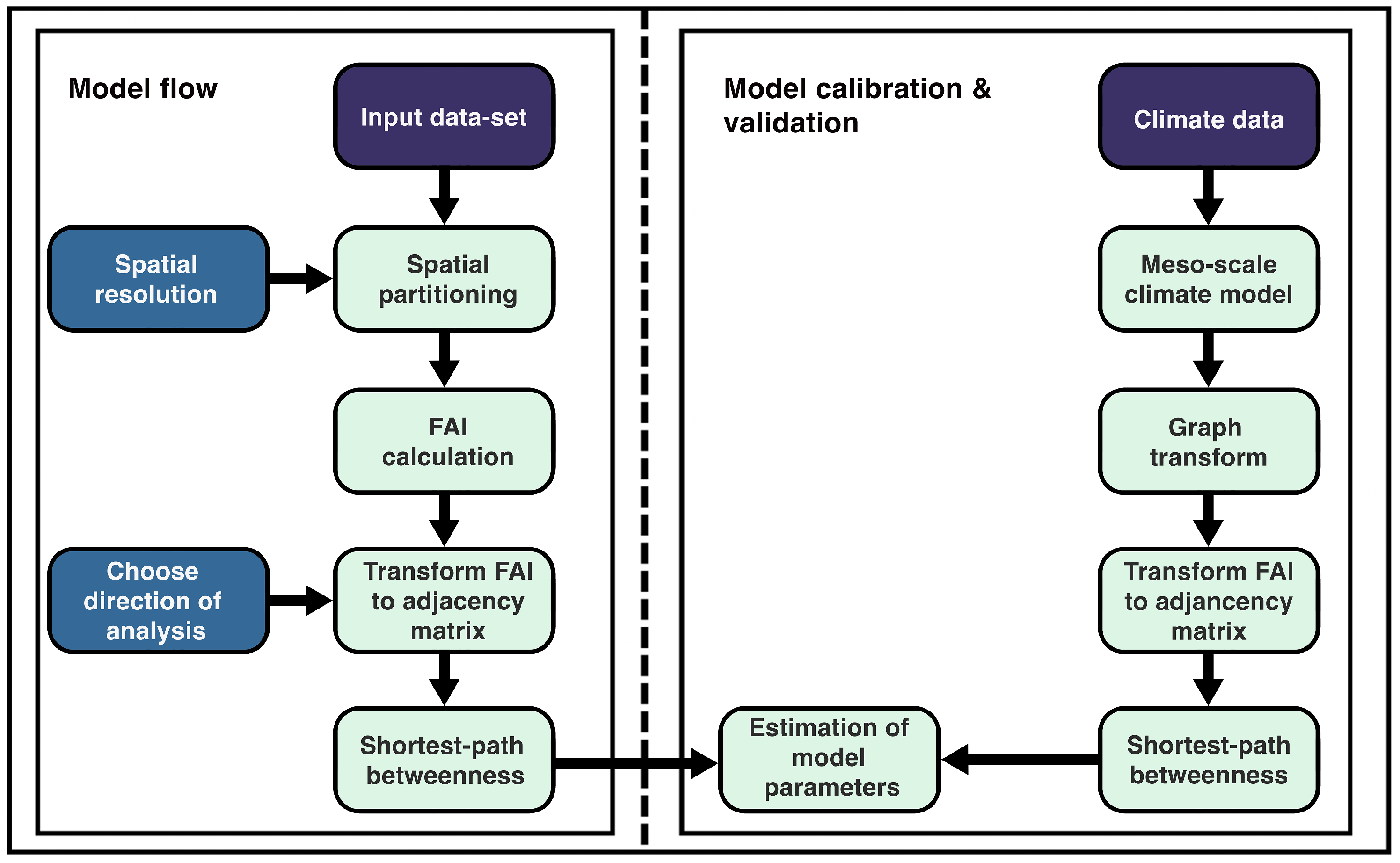


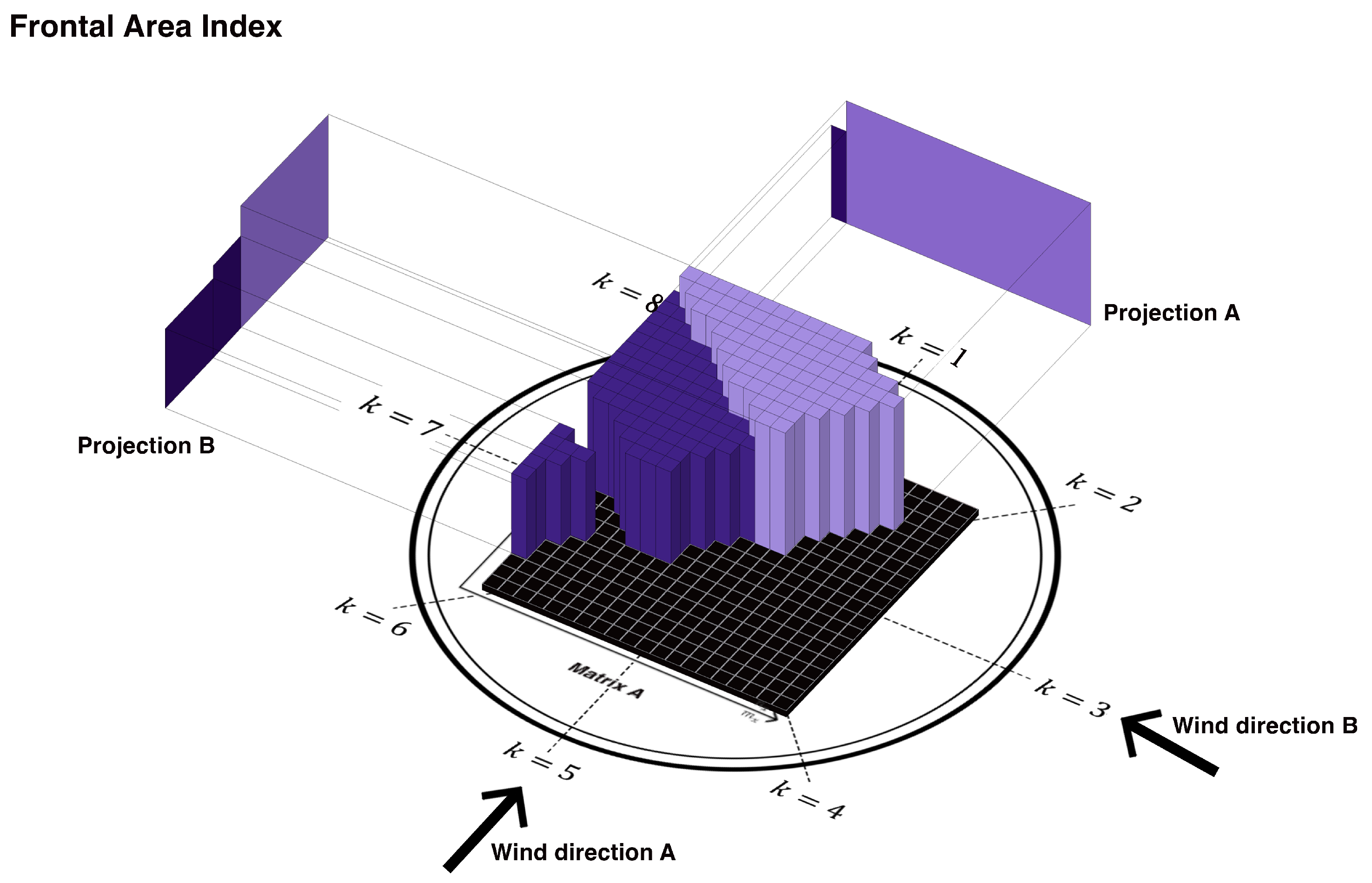
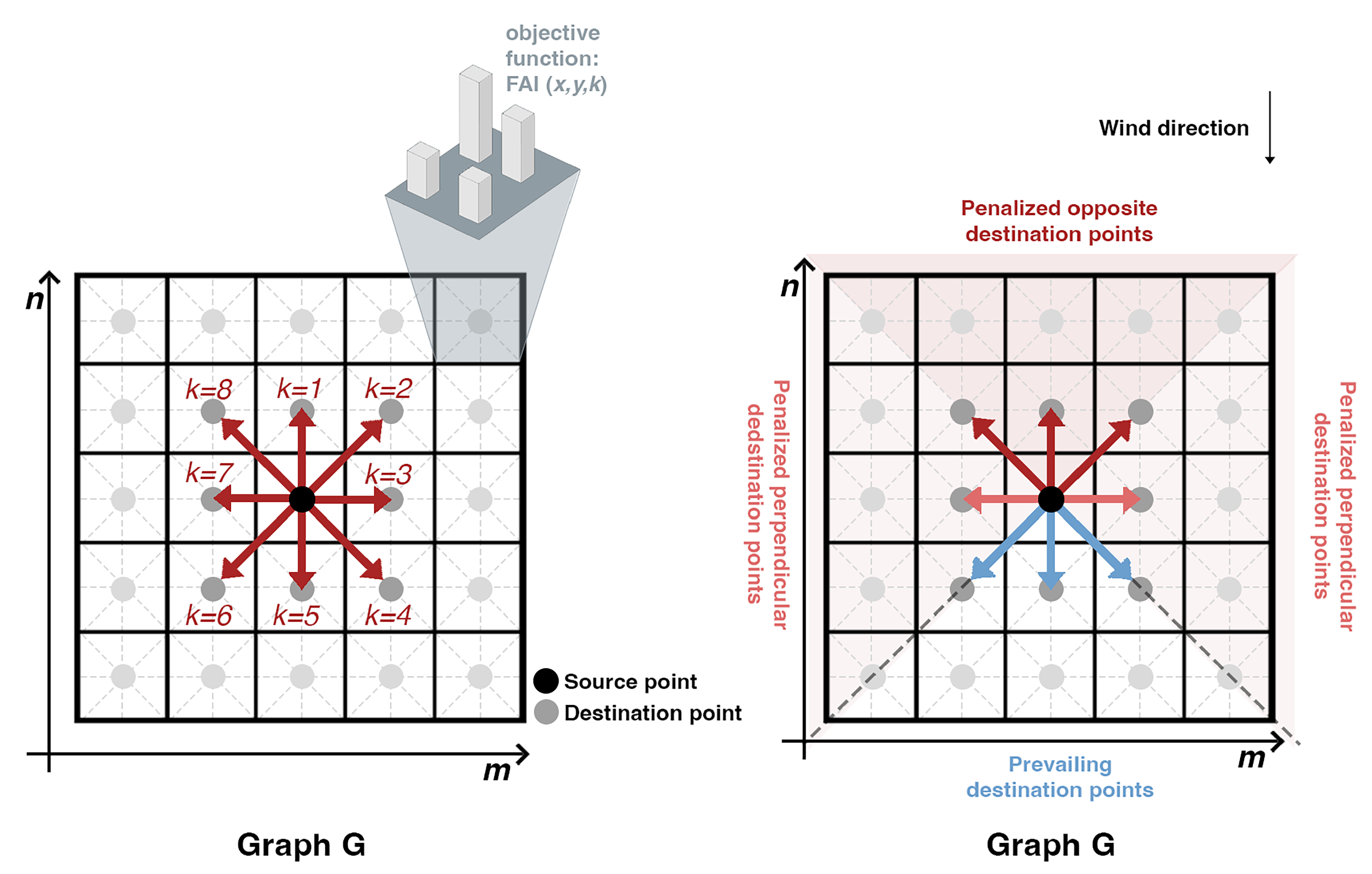
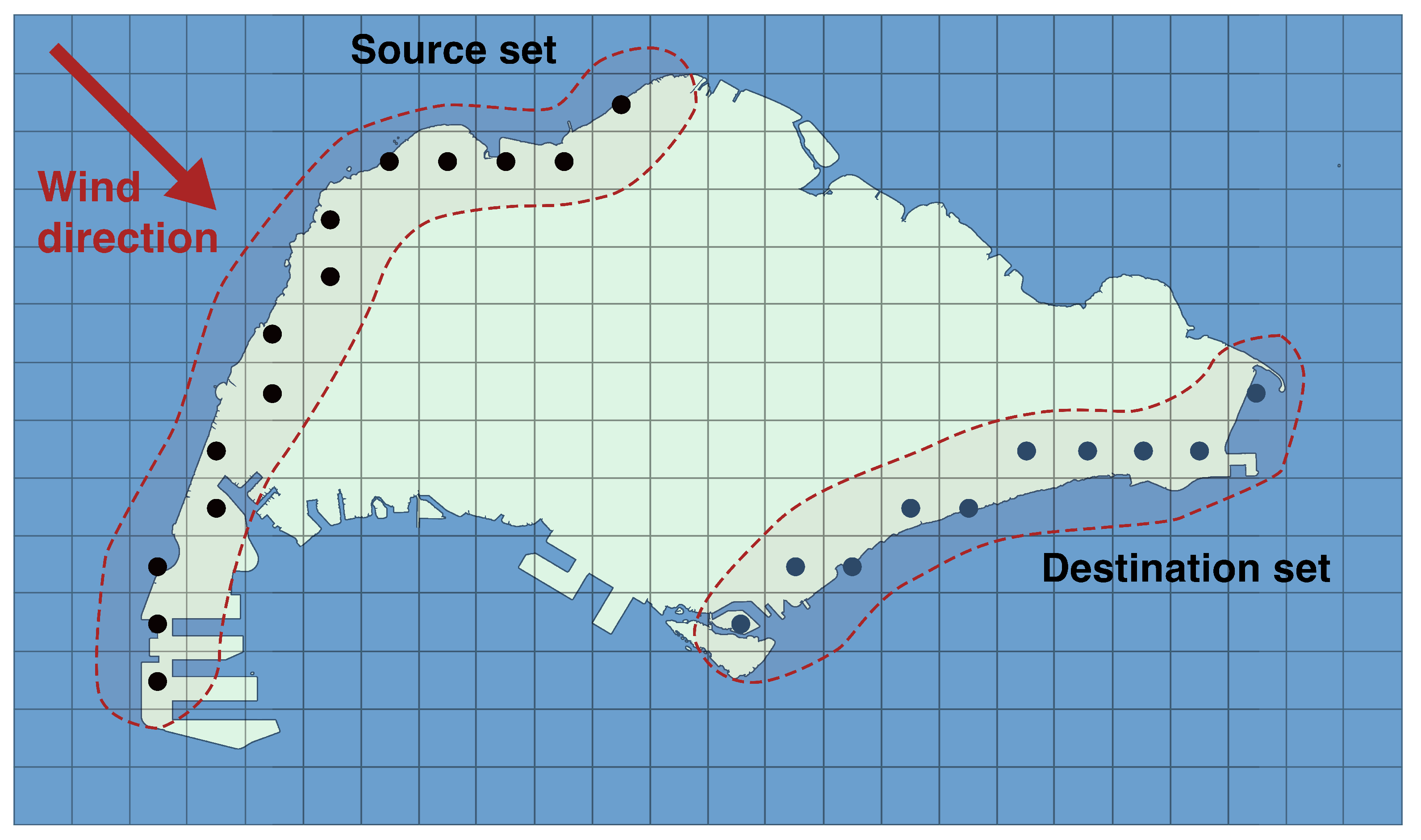

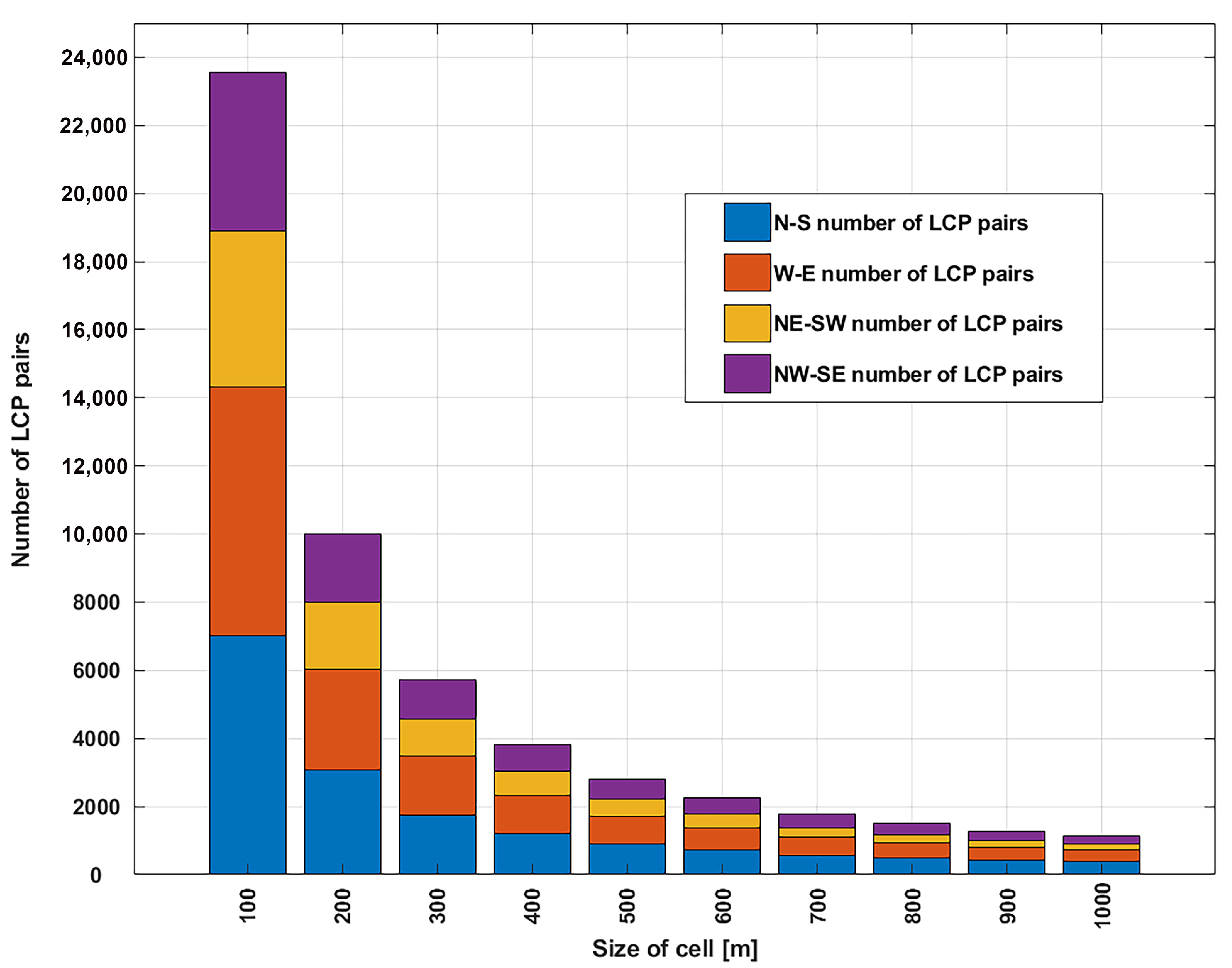
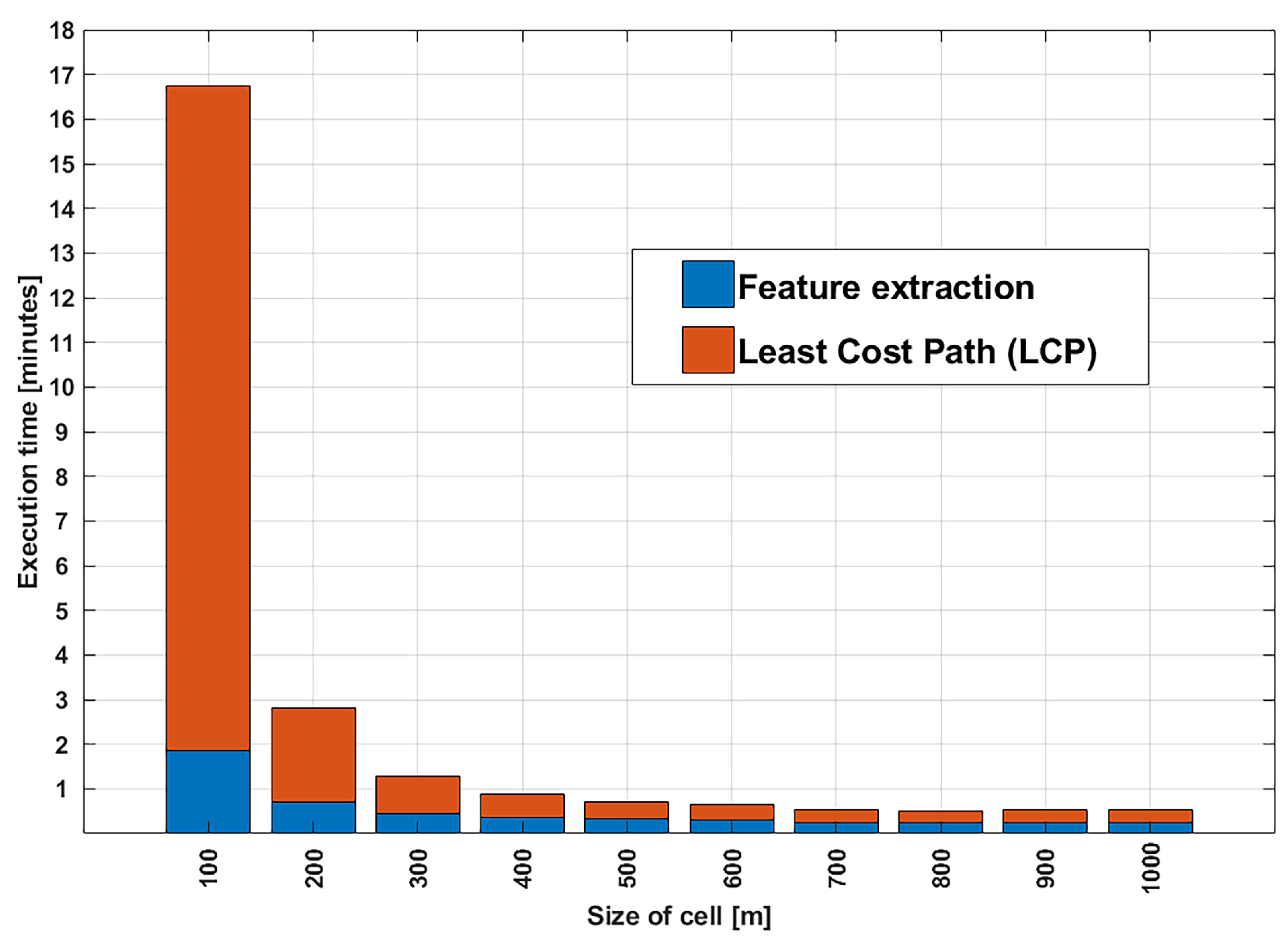
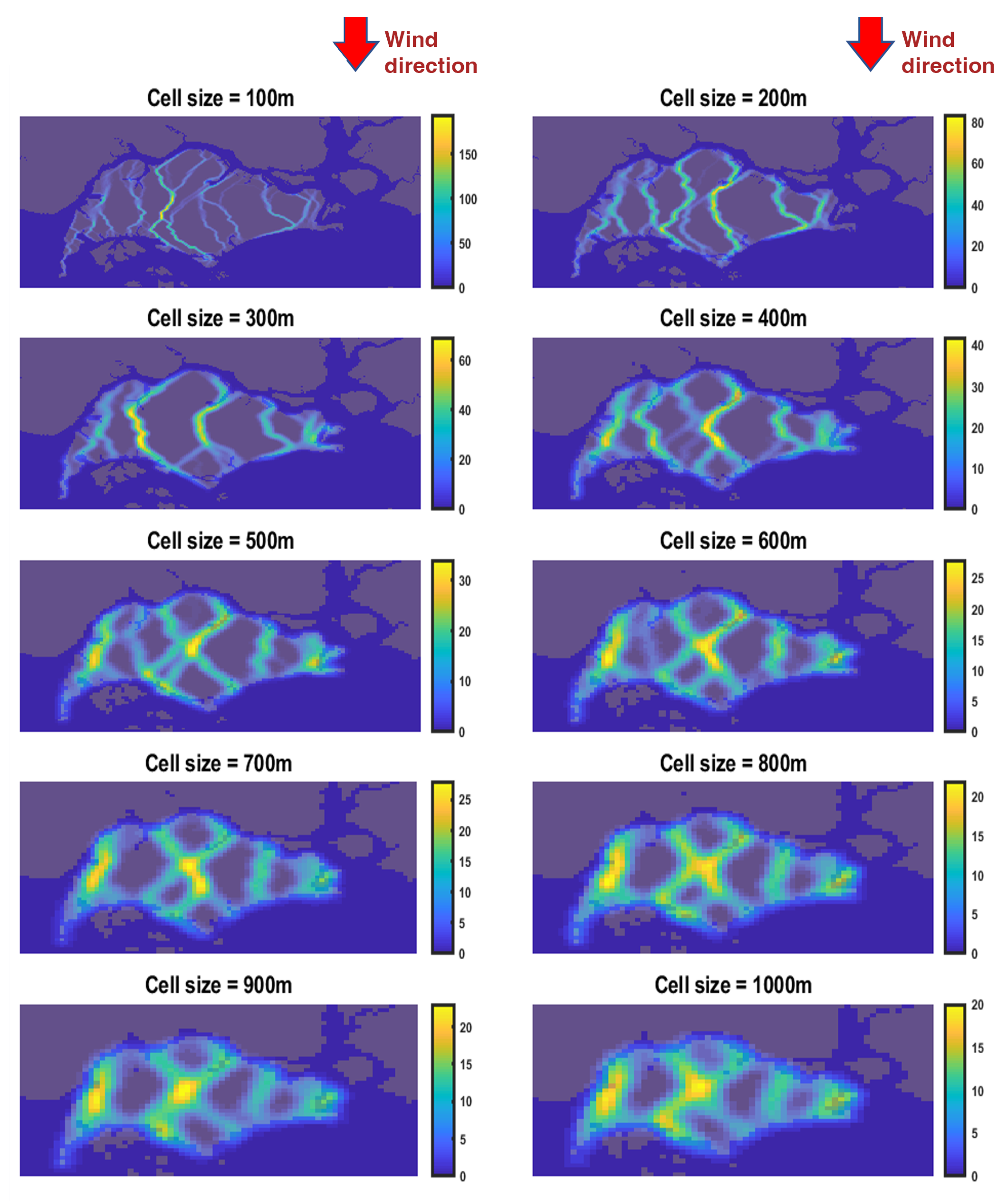

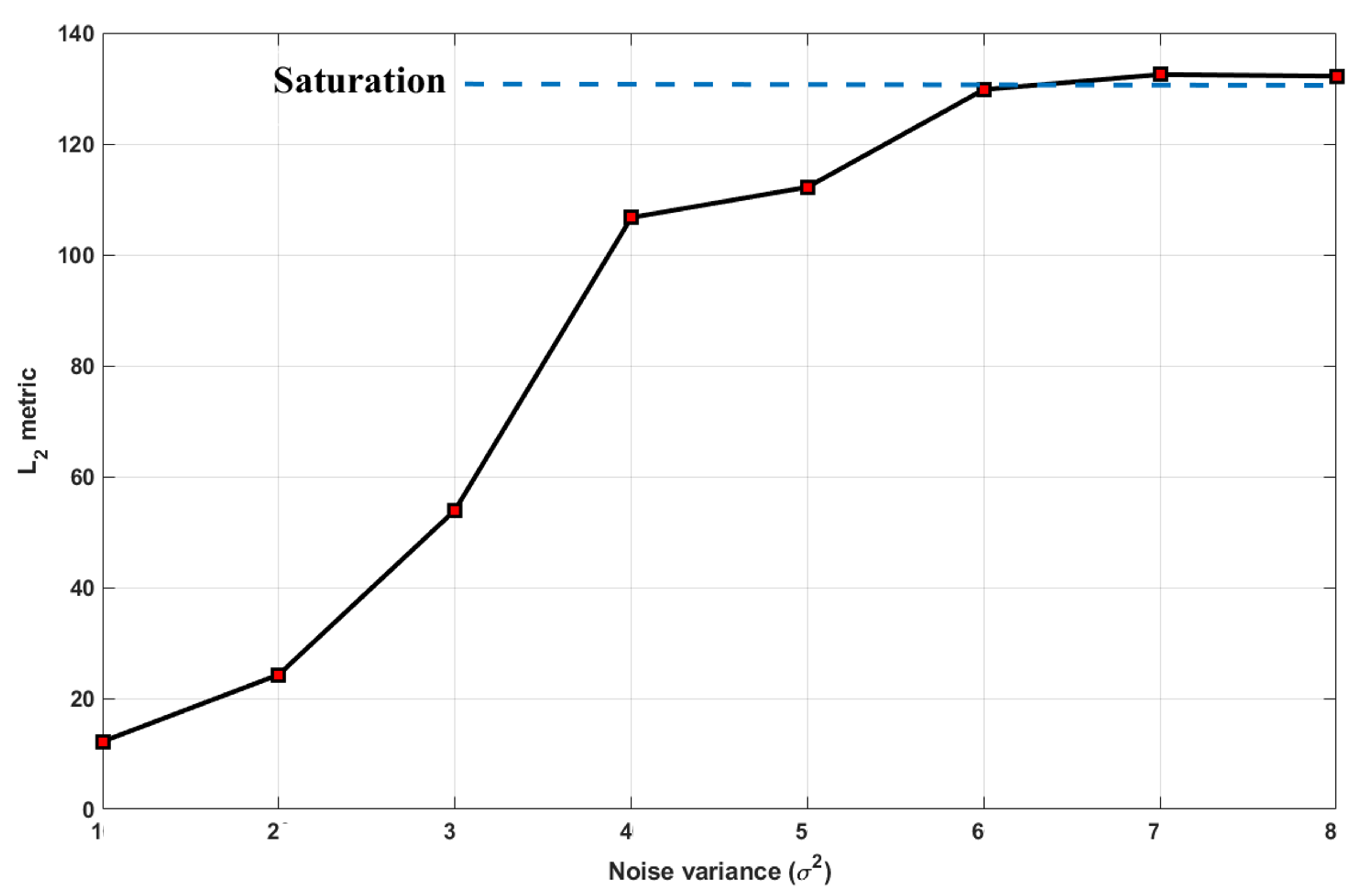
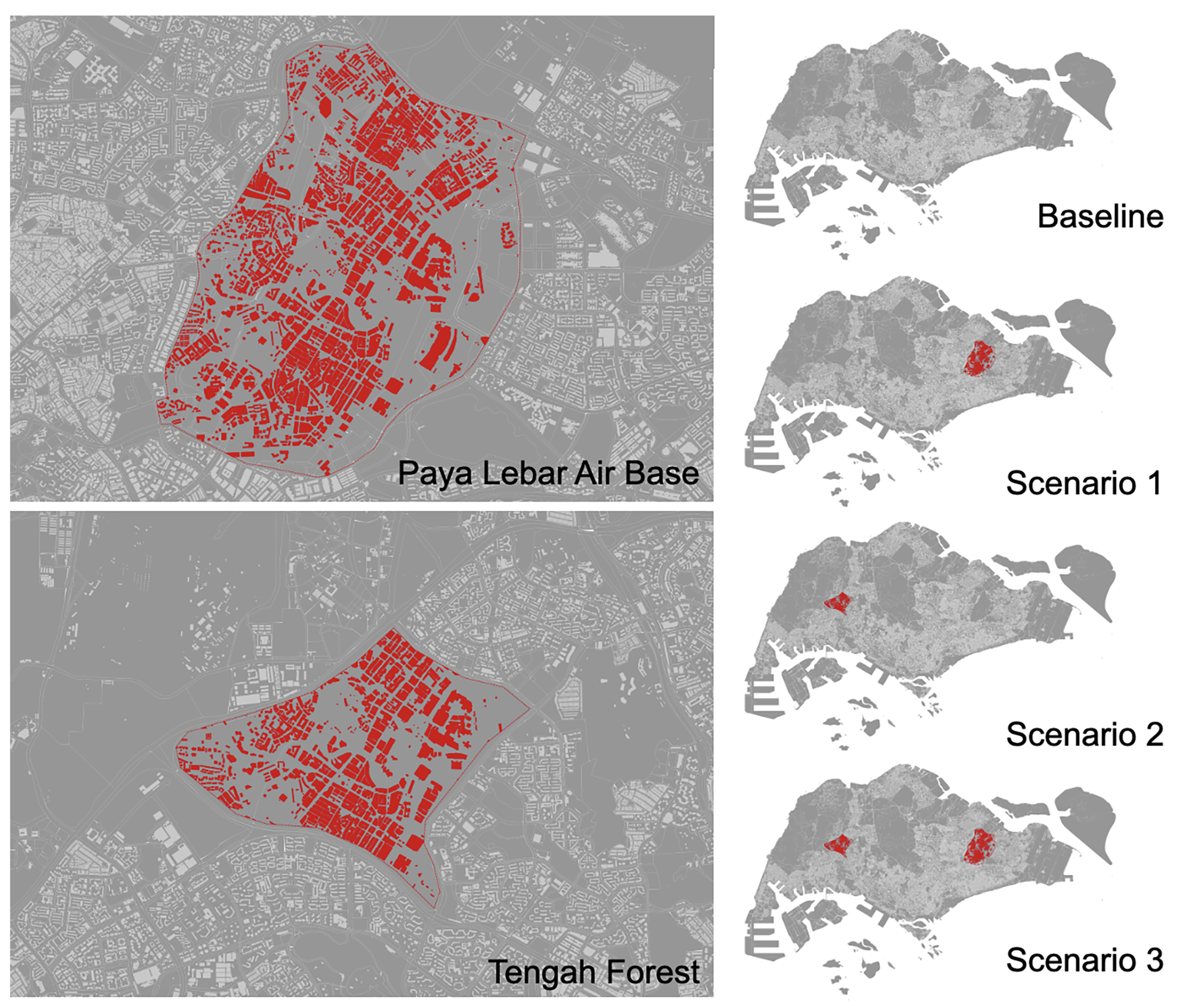

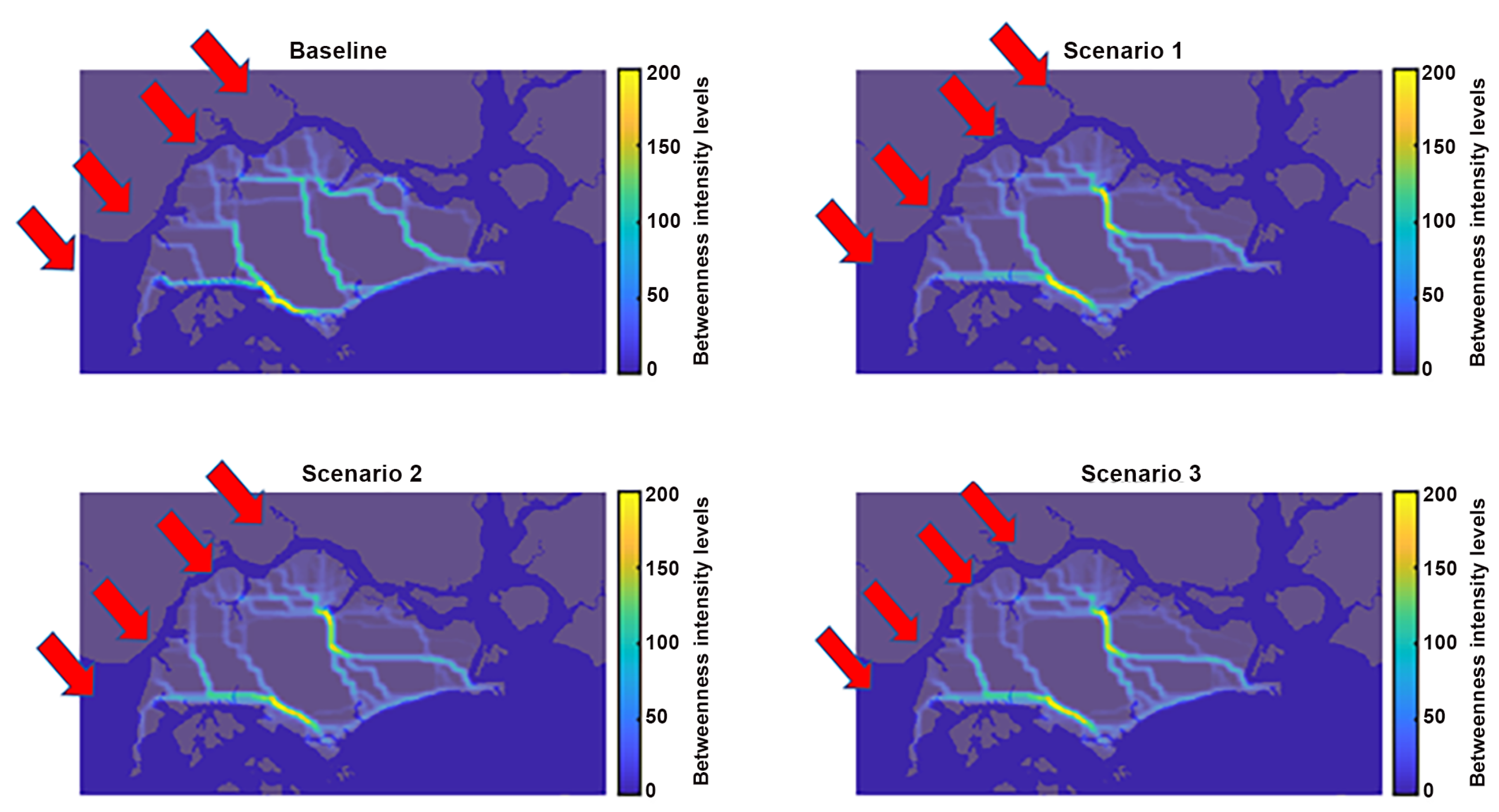
Disclaimer/Publisher’s Note: The statements, opinions and data contained in all publications are solely those of the individual author(s) and contributor(s) and not of MDPI and/or the editor(s). MDPI and/or the editor(s) disclaim responsibility for any injury to people or property resulting from any ideas, methods, instructions or products referred to in the content. |
© 2023 by the authors. Licensee MDPI, Basel, Switzerland. This article is an open access article distributed under the terms and conditions of the Creative Commons Attribution (CC BY) license (https://creativecommons.org/licenses/by/4.0/).
Share and Cite
Nevat, I.; Adelia, A.S. Urban Wind Corridors Analysis via Network Theory. Atmosphere 2023, 14, 572. https://doi.org/10.3390/atmos14030572
Nevat I, Adelia AS. Urban Wind Corridors Analysis via Network Theory. Atmosphere. 2023; 14(3):572. https://doi.org/10.3390/atmos14030572
Chicago/Turabian StyleNevat, Ido, and Ayu Sukma Adelia. 2023. "Urban Wind Corridors Analysis via Network Theory" Atmosphere 14, no. 3: 572. https://doi.org/10.3390/atmos14030572






